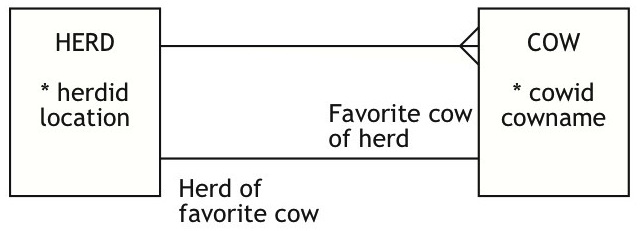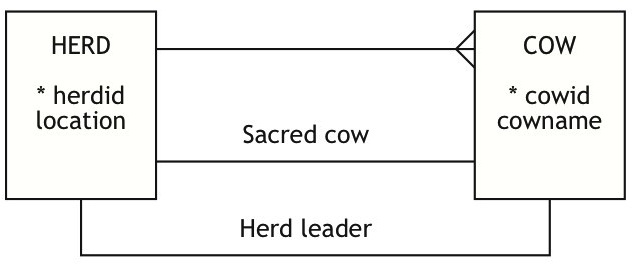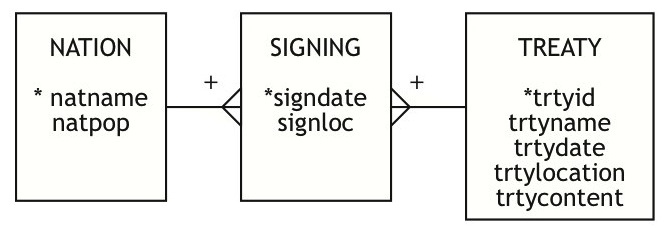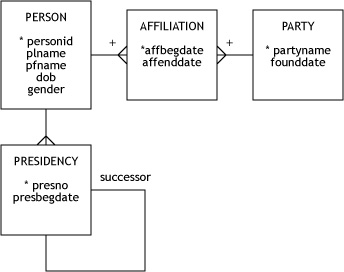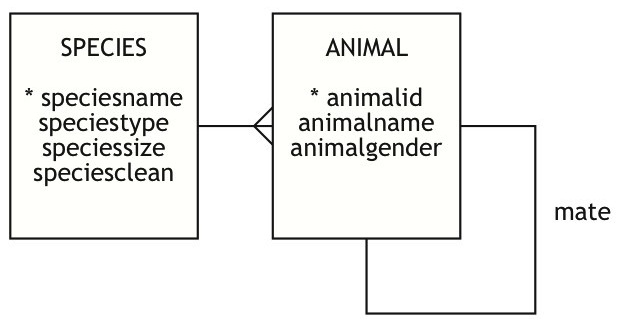
6 - One-to-One and Recursive Relationships
Answers to exercises
- 1.
Draw data models for the following problems:
- 1a.
- (i)
A dairy farmer, who is also a part-time cartoonist, has several herds of cows.
He has assigned each cow to a particular herd. In each herd, the farmer has one cow
that is his favorite--often that cow is featured in a cartoon.
- (ii)
A few malcontents in each herd, mainly those who feel they should have
appeared in the cartoon, disagree with the farmer's choice of a favorite cow, whom
they disparagingly refer to as the
sacred cow. As a result, each herd now
has elected a herd leader.
- 1b.
The originator of a pyramid marketing scheme has a system for selling ethnic
jewelry. The pyramid has three levels--gold, silver, and bronze. New associates join
the pyramid at the bronze level. They contribute 30 percent of the revenue of their
sales of jewelry to the silver chief in charge of their clan. In turn, silver chiefs
contribute 30 percent of what they receive from bronze associates to the gold master
in command of their tribe. Finally, gold masters pass on 30 percent of what they
receive to the originator of the scheme.
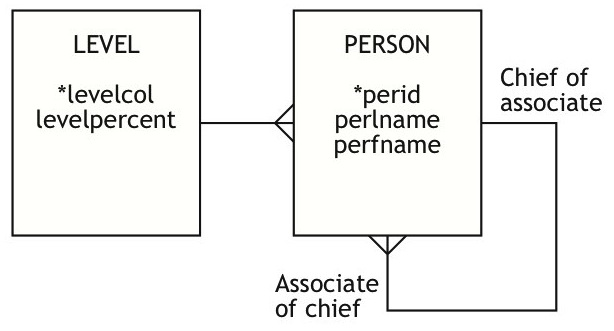
- 1c.
The legion, the basic combat unit of the ancient Roman army, contained 3,000
to 6,000 men, consisting primarily of heavy infantry (hoplites), supported by light
infantry (velites), and sometimes by cavalry. The hoplites were drawn up in three
lines. The hastati (youngest men) were in the first, the principes (seasoned troops)
in the second, and the triarii (oldest men) behind them, reinforced by velites. Each
line was divided into 10 maniples, consisting of two centuries (60 to 80 men per
century) each. Each legion had a commander, and a century was commanded by a
centurion. Julius Caesar, through one of his Californian channelers, has asked you
to design a database to maintain details of soldiers. Of course, Julius is a little
forgetful at times, and he has not supplied the titles of the officers who command
maniples, lines, and hoplites, but he expects that you can handle this lack of fine
detail.
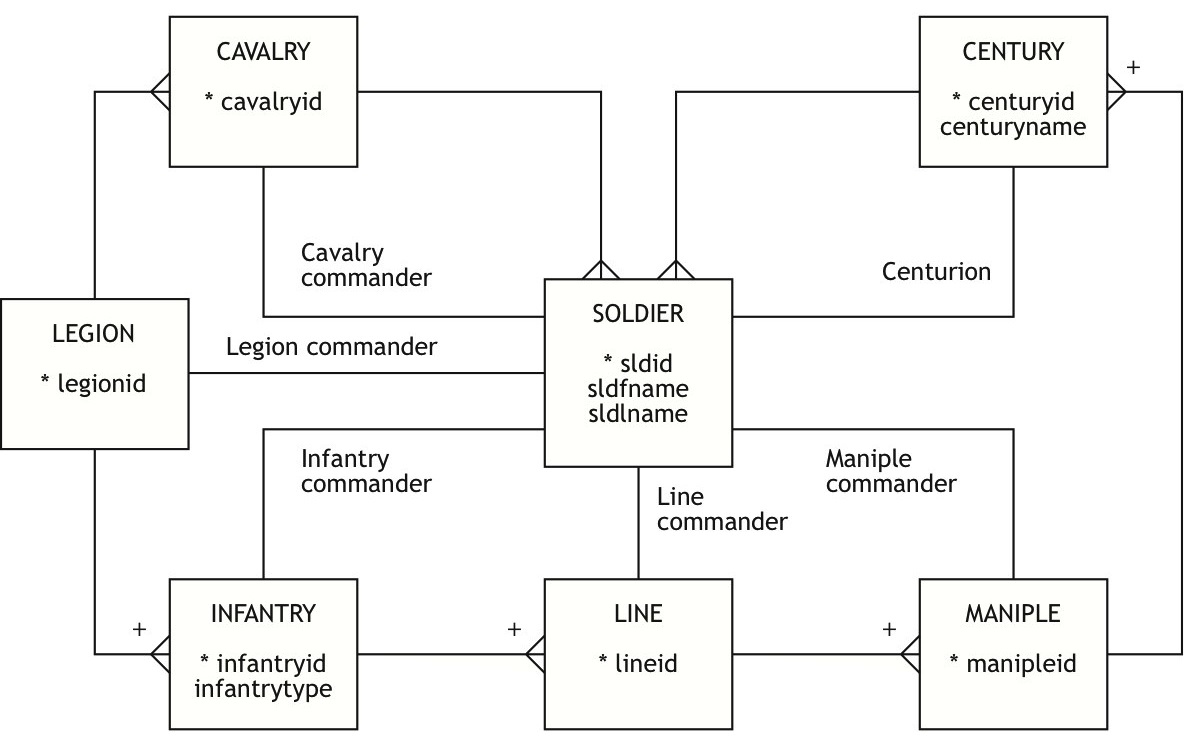
- 1d.
A travel agency is frequently asked questions about tourist destinations. For
example, customers want to know details of the climate for a particular month, the
population of the city, and other geographic facts. Sometimes, they request the
flying time and distance between two cities. The manager has asked you to create a
database to maintain these facts.
- 1e.
The Center for the Study of World Trade keeps track of trade treaties between
nations. For each treaty, it records details of the countries signing the treaty and
where and when it was signed.
- 1f.
Design a database to store details about U.S. presidents and their terms in
office. Also, record details of their date and place of birth, gender, and political
party affiliation (e.g., Caluthumpian Progress Party). You are required to record
the sequence of presidents so the predecessor and successor of any president can be
identified. How will you model the case of Grover Cleveland who served
nonconsecutive terms as president? Is it feasible that political party affiliation
may change? If so, how will you handle it?
- 1g.
The IS department of a large organization makes extensive use of software
modules. New applications are built, where possible, from existing modules. Software
modules can also contain other modules. The IS manager realizes that she now needs a
database to keep track of which modules are used in which applications or other
modules. (Hint: it is helpful to think of an application as a module.)

- 1h.
Data modeling is finally getting to you. Last night you dreamed you were asked
by Noah to design a database to store data about the animals on the ark. All you can
remember from Sunday school is the bit about the animals entering the ark
two-by-two, so you thought you should check the real thing.
Take with you
seven pairs of every kind of clean animal, a male and its mate, and two of every
kind of unclean animal, a male and its mate, and also seven pair of every kind
of bird, male and female. Genesis 7:2 Next time Noah disturbs your sleep,
you want to be ready. So, draw a data model and make certain you record the
two-by-two relationship.
- 2.
Write SQL to answer the following queries using the dept and emp tables described
in this chapter:
- 2a.
Find the departments where all the employees earn less than their boss.
WITH
wrk as (SELECT * FROM emp),
boss as (SELECT * FROM emp)
SELECT DISTINCT (deptname) FROM dept
WHERE deptname NOT IN
(SELECT wrk.deptname FROM wrk JOIN boss
ON wrk.bossno = boss.empno
WHERE wrk.empsalary > boss.empsalary);
- 2b.
Find the names of employees who are in the same department as their boss (as
an employee).
WITH
wrk as (SELECT * FROM emp),
boss as (SELECT * FROM emp)
SELECT wrk.empfname FROM wrk JOIN boss
ON wrk.bossno = boss.empno
WHERE wrk.deptname = boss.deptname;
| empfname |
| Andrew |
| Clare |
| Nancy |
| Sarah |
- 2c.
List the departments having an average salary greater than $25,000.
SELECT deptname, AVG(empsalary) FROM emp
GROUP BY deptname HAVING AVG(empsalary) > 25000;
- 2d.
List the departments where the average salary of the employees, excluding the
boss, is greater than $25,000.
SELECT deptname, AVG(empsalary) FROM emp
WHERE empno NOT IN
(SELECT empno FROM dept)
GROUP BY deptname HAVING AVG(empsalary) > 25000;
| deptname |
expr1001 |
| Purchasing |
$56,000.00 |
- 2e.
List the names and manager of the employees of the Marketing department who
have a salary greater than $25,000.
WITH
wrk as (SELECT * FROM emp),
boss as (SELECT * FROM emp)
SELECT wrk.empfname, boss.empfname
FROM wrk JOIN boss
ON wrk.bossno = boss.empno
WHERE wrk.deptname = 'Marketing'
AND wrk.empsalary > 25000;
- 2f.
List the names of the employees who earn more than any employee in the
Marketing department.
SELECT empfname FROM emp
WHERE empsalary > (SELECT MAX(empsalary)
FROM emp WHERE deptname = 'Marketing');
- 3.
Write SQL to answer the following queries using the monarch table described in
this chapter:
- 3a.
Who succeeded Victoria I?
SELECT monname, monnum FROM monarch
WHERE premonname = 'Victoria'
AND premonnum = 'I';
| monname |
monnum |
| Edward |
VII |
- 3b.
How many days did Victoria I reign?
WITH
suc as (SELECT * FROM monarch),
cur as (SELECT * FROM monarch)
SELECT suc.rgnbeg - cur.rgnbeg AS "days"
FROM cur JOIN suc
ON (suc.premonname = cur.monname AND suc.premonnum = cur.monnum)
WHERE cur.monname = 'Victoria' AND cur.monnum = 'I';
- 3c.
How many kings are there in the table?
SELECT COUNT(montype) FROM monarch WHERE montype = 'King';
- 3d.
Which monarch had the shortest reign?
WITH
cur as (SELECT * FROM monarch),
pre as (SELECT * FROM monarch)
SELECT pre.montype, pre.monname, pre.monnum, (cur.rgnbeg - pre.rgnbeg) as "days"
FROM cur JOIN pre
ON (cur.premonname = pre.monname AND cur.premonnum = pre.monnum)
WHERE (cur.rgnbeg - pre.rgnbeg) =
(SELECT MIN(cur.rgnbeg - pre.rgnbeg)
FROM monarch AS cur JOIN monarch AS pre
ON (cur.premonname = pre.monname
AND cur.premonnum = pre.monnum));
- 4.
Write SQL to answer the following queries using the product and assembly tables:
- 4a.
How many different items are there in the animal photography kit?
SELECT COUNT(*) FROM product JOIN assembly
ON product.prodid = assembly.prodid
WHERE proddesc = 'Animal photography kit';
- 4b.
What is the most expensive item in the animal photography kit?
SELECT proddesc FROM product
WHERE prodprice =
(SELECT MAX(prodprice) FROM product
WHERE prodid IN (SELECT subprodid FROM product JOIN assembly
ON product.prodid = assembly.prodid
WHERE proddesc = 'Animal photography kit'));
- 4c.
What is the total cost of the components of the animal photography kit?
SELECT SUM(PRODCOST*quantity) AS 'Total cost' FROM product JOIN assembly
ON product.prodid = assembly.subprodid
WHERE product.prodid IN
(SELECT subprodid FROM product JOIN assembly
ON product.prodid = assembly.prodid
WHERE proddesc = 'Animal photography kit');
- 4d.
Compute the total quantity of all items required to assemble 15 animal
photography kits.
SELECT 15*SUM(quantity) AS Quantity FROM product JOIN assembly
ON product.prodid = assembly.subprodid
WHERE product.prodid IN
(SELECT subprodid FROM product JOIN assembly
ON product.prodid = assembly.prodid
WHERE proddesc = 'Animal photography kit');
This page is part of the promotional and support
material for Data Management (open edition) by Richard T. Watson
For
questions and comments please contact the
author |
Date revised:
10-Dec-2021

